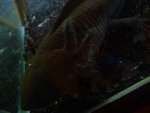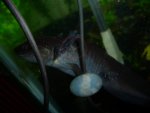AuraCantos
New member
- Joined
- Sep 26, 2009
- Messages
- 107
- Reaction score
- 4
- Points
- 0
- Location
- Maryland
- Country
- United States
- Display Name
- Jackie Blackwell
After my fight with Planaria in my 40g lotl tank, (which I won, thanks), my Wild Type's gills have been less than fluffy. Missing in some parts, the feathers thinned out, ect. Once the planaria were mostly gone, they seemed to be recovering- fluffed out, normally active, happy... But over the last couple of days, he and my Melanoid have gotten this white substance on their gills. From what I can tell, it doesn't look particularly like a fungus... It's not usually attached to the actual stem, but seems to be more caught up in the fimbrae(feathers). And it's not in spherical shape, like I see some of the other photos of fungus that grow along the gills. It's more... drape-like. I want to be 100% sure this isn't a fungus, though, before I dismiss it!
Could this possibly be from where some of the fimbrae have died, and the white substance is the dead tissue?
I mentioned in another post that I have previously tried salt baths on my Melanoid. The process was nothing but traumatizing. Cole thrashed and rolled around in the tub before I scooped him out. I followed the forum instructions, 1-2tsp per litre of water. I'd rather NOT have to salt bath again, but if I have to, I'll try to.
As a note, it got warm yesterday and the tank went up from its normal 62f to around 66f. I put a fan on it last night before bed, and over a 12-hour period, the tank cooled from that to about 55f. I think if it were a fungus, it'd spread alot slower in these conditions.
ANY help is appreciated!
Could this possibly be from where some of the fimbrae have died, and the white substance is the dead tissue?
I mentioned in another post that I have previously tried salt baths on my Melanoid. The process was nothing but traumatizing. Cole thrashed and rolled around in the tub before I scooped him out. I followed the forum instructions, 1-2tsp per litre of water. I'd rather NOT have to salt bath again, but if I have to, I'll try to.
As a note, it got warm yesterday and the tank went up from its normal 62f to around 66f. I put a fan on it last night before bed, and over a 12-hour period, the tank cooled from that to about 55f. I think if it were a fungus, it'd spread alot slower in these conditions.
ANY help is appreciated!




